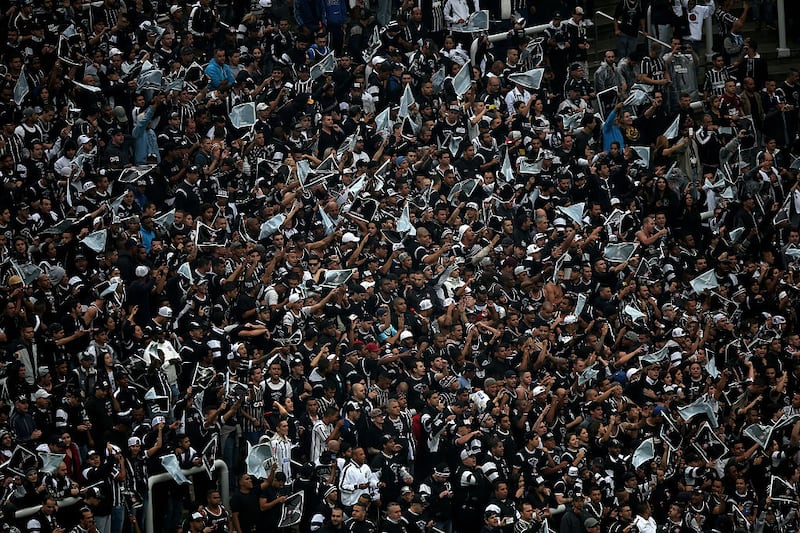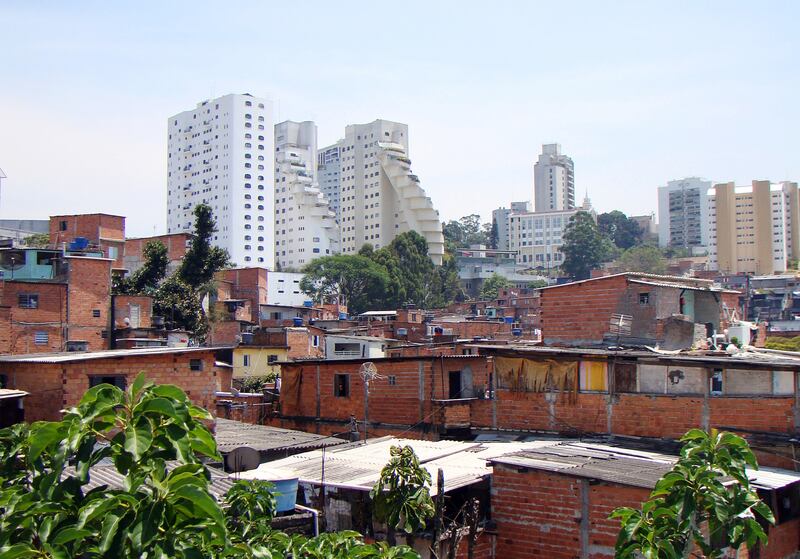In a place that is so passionate about football and where society can be so violent – there are more murders in Brazil than in any other country in the world – it is no surprise that bloody and even fatal confrontations between rival fans are common. With so many big clubs and intense derbies in São Paulo, the biggest city in the southern hemisphere, you might expect there to be regular clashes between supporters. That was the case until recently, but something has changed in the last few months.
Fan violence was a huge problem in São Paulo a decade ago. In 2015, eight members of a Corinthians fan group were murdered by gunmen while they enjoyed a BBQ and prepared flags for their upcoming derby against Palmeiras. During another derby between the two sides, a fan stole a police officer’s gun during a riot outside Palmeiras’ ground.
The final straw came on April 3rd, 2016, when Palmeiras and Corinthians met at the Pacaembu stadium. There were fights before and after the match; the vandalism around the city was severe; and a fan was killed in an eastern suburb nearly 20 miles away from where the game was played.
The authorities reacted by bringing in the Torcida Única ruling, which stated that only home fans could attend a classico between any of the “big four” clubs in São Paulo – Corinthians, Palmeiras, Santos and São Paulo. The rule has been in place for the last seven years, but it has not been effective.
‘I’m the right guy in the right moment’ says new Manchester United boss Ruben Amorim
Kevin Kilbane: Sharp criticism for coaching role in Israel may see Robbie Keane turn to Major League Soccer
‘I think Bulgaria is an okay draw’ - Heimir Hallgrímsson reacts to Ireland’s playoff opponents
Premier League clubs approve APT rule changes in blow to Manchester City
Even before the first game it covered – a São Paulo state championship semi-final between Santos and Palmeiras in April 2016 – the then-Palmeiras president Paulo Nobre warned that it would “not put an end to violence in football because the problems do not occur inside the stadium”. He has been proven right. In July 2017, the Palmeiras supporter Leandro de Paula Zanho was stabbed by two Corinthians fans outside a shop in downtown São Paulo three miles from the stadium.
The Torcida Única ruling did little to end fan violence, but another intervention has led to a truce between rival supporters. It has nothing to do with the presence of away fans, or any policy put in place by the Brazilian authorities. Instead, the recent fall in fan violence is due to the most surprising of interventions – at least to foreign eyes who do not see the complexities of life in Brazil.
On February 10th this year, Palmeiras ultras ambushed two buses of Corinthians fans who were returning from a match against São Bernardo. There was a battle between the supporters, which left fans on both sides in hospital. The attack – carried out with fireworks, stones and iron bars – caused traffic to halt on a busy road leading to the city centre in the early hours of a Friday morning. Palmeiras supporters posted photos online, bragging about how they had stolen musical instruments from their rivals.
However, they did not know that a member of the Primeiro Comando da Capital crime organisation was on one of the buses and had apparently been hurt in the fracas. Referred to locally as the “PCC” or the “Comando”, the gang was formed by eight convicts in the Piranhão jail in August 1993. Football played its part in their early days. They played in a prison football team together but their solidarity had other advantages. As their group grew in numbers, they set about fighting oppression in the prison system and avenging the death of 111 prisoners who had been slain in the 1992 Carandiru massacre, a story immortalised on film by the late and legendary director Héctor Babenco.

The group has since become the biggest criminal organisation in Brazil and among the most powerful in South America. It boasts an estimated 20,000 members in Brazil and has its tentacles spread through Peru, Venezuela, Ecuador and Paraguay, where it allegedly controls much of the continent’s drug trade. Narcotics flow through South America and are then shipped across the Atlantic to Europe and Western Africa.
The group controls prisons throughout Brazil and various neighbourhoods in São Paulo. Heist jobs are a common calling card. In 2017, they pulled off the “robbery of the century” on the offices of the security company Prosegur in Paraguay, using snipers, bombs and bulletproof vehicles to fight off police and steal anywhere between $8 million and $40 million. The action movie-like scenes were broadcast on national news channels.
When the PCC spread from the prison system to the streets in the early 2000s, it took control of São Paulo’s favelas. Locals say the areas were lawless at the time, with police either uninterested or unable to catch and prosecute rapists and murderers. Jardim Ângela, in the city’s southern suburbs, was declared the “homicide capital of the world” by the United Nations in 1996. Residents say each house was missing a son, either dead or in prison.
São Paulo has become a more peaceful place in the last 20 years. The murder rate fell from 35.7 per 100,000 people in 1999 to 8.7 in 2016, prompting the state’s governor at the time, Geraldo Alckmin, to credit the work of heroic police officers. Policing in the city has certainly modernised, with new technology and approaches used to combat crime. Other researchers have noted the impact of falling unemployment, tighter access to alcohol and gun controls.
However, some academics have suggested that the dominance of a single gang – the PCC – has been a major reason for the 73 per cent drop in homicides. Cambridge University professor Graham Denyer Willis argues that the dominance of the PCC is “the main factor on life and death in São Paulo”, saying the group is “a product, producer and regulator of violence”. The decrease in murders was “too abrupt” to be explained by long-term factors such as socioeconomic advances and changes in policing, he told BBC Brasil.
“The fall was so rapid that it did not indicate a socioeconomic or policing factor, which would be something long-term. It took place in several spaces of the city around the same time. And there is no data on specific public policies in these locations to explain these trends,” explained Willis, who based his findings on time spent with homicide police in São Paulo and his access to internal documents seized from a PCC member that helped him write his fascinating book The Killing Consensus.
The state government says his theory is “ridiculous”, but plenty of locals attest to the impact of the PCC’s rule by fear strategy. When the group took control of the favelas in the early 2000s, it warned less organised gangs to either disarm or join their ranks if they did not want to be wiped out. Resident-on-resident crimes were outlawed and anyone found breaking any of their rules was brought before their “crime court”.
The group does not just deal with serious crimes, but also resolves domestic squabbles, even arbitrating on extramarital affairs. They are judge and jury, and mete out punishments as they see fit – and their form of justice is swift and brutal. Anyone committing a crime without their say, or against their interests, will be punished.
In neighbourhoods such as Paraisópolis, the second largest favela in São Paulo, court hearings are often held on the pitch of the local football team in front of a group of gang leaders. Video calls are used to include the opinions of those behind bars, and crimes committed against the elderly, single mothers and pregnant women are punished particularly severely, with beatings, banishment from the community or, in the worst cases, the death penalty inflicted on the guilty party.

The PCC sends out “salves” – orders that are spread through WhatsApp that must be followed by gang members and the local community. After the violence on the motorway between rival football fans earlier this year, the PCC sent an order to ultra groups in São Paulo demanding they stop fighting in the state.
After meeting the gang, ultra groups affiliated to three of the big four clubs in the city – the Mancha Verde (Palmeiras), Torcida Jovem (Santos), and Independente (São Paulo) – published official notes prohibiting their members from engaging in “acts of violence or cowardice”. The Gaviões (Corinthians) did not publish anything, however.
Mancha Verde president Jorge Luis told the press that the groups had met each other and decided it was “time to seek peace” as “scenes of savagery” will no longer be tolerated. He denied that he had spoken to anyone from “organised crime”, but a member of the PCC, who wished to remain anonymous, has confirmed that the salve to end fan violence was indeed sent to the ultra groups, with “consequences” due for anyone who disobeyed it.
Even if the gang did not intervene, the rumour may be powerful enough to keep the peace. “If this story about the PCC is true or not, it’s difficult to know,” said one São Paulo fan. “But what is true is the effect that it’s having on the supporters. Who’s going to fight now? Nobody will risk or challenge an order from the PCC.”
Fan violence has quietened in São Paulo in recent months, but it continues to rage elsewhere in Brazil. A Fluminense supporter was shot dead in a bar near the Maracanã after the Rio State Championship final last Saturday. América fans clashed with police in the stands at the Minas Gerais state championship final last week. And, the week before in Porto Alegre, an Internacional fan invaded the pitch (with his child) and attacked a rival team’s player during a Rio Grande do Sul State Championship semi-final.
Meanwhile, the truce is holding in São Paulo. Some hopeful fans are dreaming of an end to the era of Torcida Única. Will the peace last? Time will tell. But it will take a brave, or stupid, fan to break it. – Guardian





